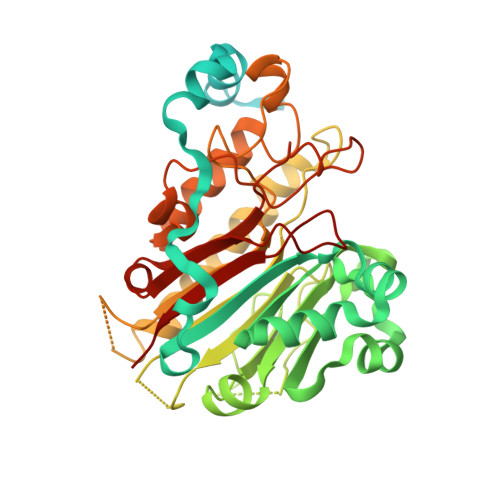Crystal Structure and DNA Repair Activities of the Ap Endonuclease from Leishmania Major.
Vidal, A.E., Harkiolaki, M., Gallego, C., Castillo-Acosta, V.M., Ruiz-Perez, L.M., Wilson, K., Gonzalez-Pacanowska, D.(2007) J Mol Biol 373: 827
- PubMed: 17870086
- DOI: https://doi.org/10.1016/j.jmb.2007.08.001
- Primary Citation of Related Structures:
2J63 - PubMed Abstract:
Apurinic/apyrimidinic endonucleases initiate the repair of abasic sites produced either spontaneously, from attack of bases by reactive oxygen species or as intermediates during base excision repair. The catalytic properties and crystal structure of Leishmania major apurinic/apyrimidinic endonuclease are described and compared with those of human APE1 and bacterial exonuclease III. The purified enzyme is shown to possess apurinic/apyrimidinic endonuclease activity of the same order as eukaryotic and prokaryotic counterparts and an equally robust 3'-phosphodiesterase activity. Consistent with this, expression of the L. major endonuclease confers resistance to both methyl methane sulphonate and H2O2 in Escherichia coli repair-deficient mutants while expression of the human homologue only reverts methyl methane sulphonate sensitivity. Structural analyses and modelling of the enzyme-DNA complex demonstrates a high degree of conservation to previously characterized homologues, although subtle differences in the active site geometry might account for the high 3'-phosphodiesterase activity. Our results confirm that the L. major's enzyme is a key element in mediating repair of apurinic/apyrimidinic sites and 3'-blocked termini and therefore must play an important role in the survival of kinetoplastid parasites after exposure to the highly oxidative environment within the host macrophage.
Organizational Affiliation:
Instituto de Parasitología y Biomedicina López-Neyra, Consejo Superior de Investigaciones Científicas, Avda. del Conocimiento s/n, 18100 Armilla, Granada, Spain.














